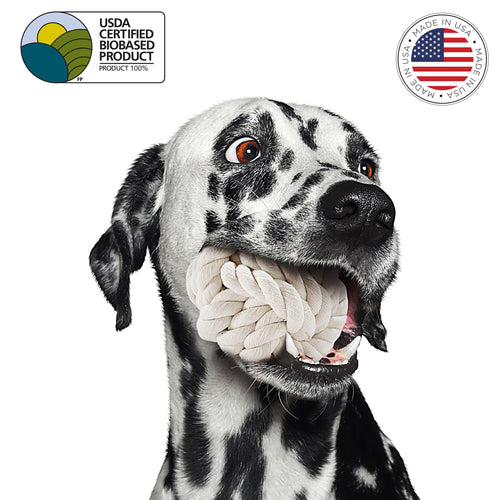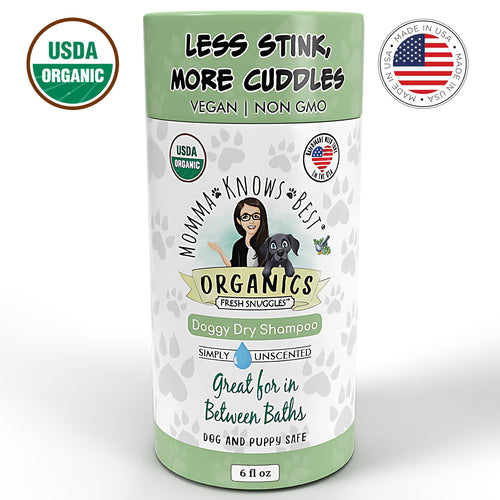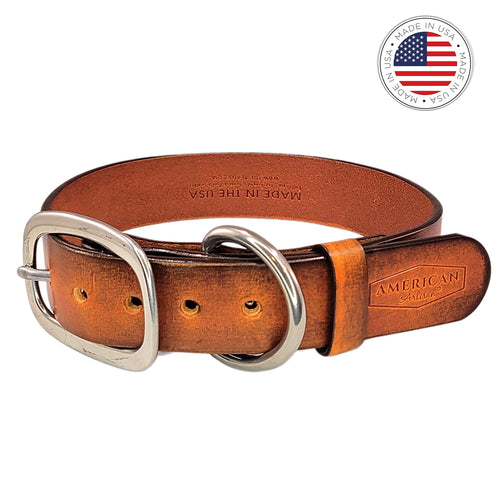Your Cart is Empty
Free 2-5 day delivery | No minimum purchase required
Free 2-5 day delivery | No minimum purchase required
Shop
Learn
The Truth Behind Zeus, The World’s Largest Great Dane
 by K Marie Alto Updated
10 min read
by K Marie Alto Updated
10 min read

Some dogs are very small. The smallest dog in the world was just four inches tall and could sit in a teacup. Other dogs? They're very large. They are so large, in fact, that they rival the size of a full-scale wolf. Some? They're even bigger than that.
There are many large breeds of dog, but one stands above the rest – literally. It's the Great Dane, the current holder of the world record for tallest dog ever recorded. The specific tallest Great Dane is one named Zeus.
What is the truth behind Zeus? Don't worry; there's no dark secret, no "allegations" or doping involved here. Just a very large, good boy.
Table of Contents
All About Zeus, the World's Largest Great Dane
Zeus was the official record holder for the world's largest Great Dane and, consequently, the world's largest dog. He was also a very good dog; despite his huge stature, he was a loving lap dog when given the chance. He liked nothing more than to hang out in the laps of his parents while they spent time on the porch.
He was also a certified therapy dog, often visiting hospitals and schools around his hometown in the Kalamazoo, Michigan, area. His gentle demeanor and immaculate training helped him ease the anxieties of students, hospital patients, and many more people besides.
Zeus was a huge dog, and huge dogs have huge lives. At his peak, he weighed 155 pounds (more than some people!) and was tall enough that he could drink from a kitchen sink without having to work for it. He ate a whopping 12 cups of food a day to sustain his massive frame.
When measured, from his front paw to his withers (the front shoulder of a quadruped), he was three feet and eight inches tall. When standing on his hind legs, he could stretch up to seven feet and five inches.
Remember those wolves I mentioned in the intro? The average wolf is only 2.5-3 feet tall at the shoulder. Great Danes stand as tall or taller than wolves! Of course, wolves are bulkier and fluffier than Danes, so it's hardly a fair comparison.

Unfortunately, Zeus passed away in 2014, at the age of six, from symptoms of old age. This is one sad and unfortunate truth: the larger a dog is, the shorter their life span is going to be. Smaller breeds (without health complications) can live to be 14 or older, but giant breeds like Great Danes often only live to be around six, up to 10 at the oldest. For a dog as large as Zeus, six was on the shorter end of expected but still within expectations.
Zeus held the title of the world's tallest living dog while he was alive. After his passing in 2014, his record was taken by a dog named Freddy, also a Great Dane, from Leigh-on-Sea, Essex, England. Freddy was slightly shorter than Zeus, but since the record was for the world's tallest living dog, it naturally had to move on.
Freddy passed away at the age of 8 in 2021. His successor was another dog named Zeus, this time from Bedford, Texas. This Zeus was also a hair shorter than the previous Zeus, though he came closer. He has passed as well; a diagnosis of bone cancer led to the amputation of his leg, and complications from that surgery caused pneumonia that led to his end.
The current tallest living dog is named Kevin, after Kevin McAllister from Home Alone, and stands three feet and two inches from foot to withers. He's from Des Moines, Iowa. For now, anyway, he holds the record until another tall dog comes along to challenge him.
For fans of the original Zeus, don't worry; he still holds a world record as the tallest dog ever recorded, which even his successors as the tallest living dog don't match.
Everything to Know about Great Danes
If you love the idea of a giant canine by your side, there's a lot to know about them. Giant breeds like Great Danes are definitely larger-than-life, but the reality of caring for one as a pet parent needs some grounding before you go find a puppy to adopt.
As a giant dog breed, Great Danes fortunately have a very pleasant temperament. They're fairly good with children and other dogs, though sometimes their size can cause problems just out of sheer bulk and scale. Luckily, they're also very affectionate and loving; otherwise, they could be very scary creatures.

The Great Dane was officially recognized as a breed by the American Kennel Club all the way back in 1887. They're known by a bunch of different names around the world, including German Mastiffs, Boarhounds, and Grand Danois. Once upon a time, they were commonly seen as guardian dogs for the German nobility and were often used as hunting dogs when pursuing prey like boar, deer, and even bears.
Most Great Danes aren't as large as Zeus and his successors. The breed is usually around 32" tall at the shoulder (where Zeus was 44"), with some smaller and some larger. They're still massive, but they're also fairly lean dogs. They aren't as chunky or as fluffy as other huge breeds like Newfoundlands, Saint Bernards, or other mastiffs. In fact, their coats are generally short and sleek, almost similar to horses in a way.
The Health of the Great Dane
As a giant breed, health is extremely important. Danes are susceptible to a variety of illnesses, but the number one cause of death for Danes is GDV, Gastric Dilation-Volvulus, also known as Bloat. This is an awful condition, also known as "twisted stomach," wherein the dog's stomach is excessively stretched, rotates due to excessive gas, and gets cut off. It's an illness that can affect dogs primarily, but in rare cases, it can even affect cats and guinea pigs. It's simply more common the larger and deeper-chested the breed or species is.
Since GDV is such a risk and has such a high mortality rate, some Dane parents get a prophylactic surgery that can help with some of the worst aspects of it and buy more time if it does occur.

Danes can also develop eye issues, hypothyroidism, cardiac problems, autoimmune thyroiditis, and hip dysplasia, especially as they get older. Great Dane breeders screen for conditions as much as possible, and responsible pet parents make sure to get Dane-specific medical examinations regularly.
Caring for a Great Dane
Taking care of a dog the size of a Great Dane is no easy feat. Fortunately, since they're affectionate and loving, they're also fairly easy to train and aren't going to be too headstrong, at least in general. Individuals, of course, can vary.
Danes have short coats and don't shed much, but even a little bit of shedding in a dog that size is going to be a lot of fur. Moreover, they do have an annual shedding season, where they shed a lot more. You'll need to brush them at least once a week and possibly daily during shedding season. Otherwise, their coats are fairly easy to care for, and you only need to give them a bath occasionally.
Definitely make sure to keep their nails trimmed. Since their feet are huge and they have a lot of weight behind them, over-long nails can cause pain, they can scratch your floors, and they can lead to problems with walking and even joints down the line.
Dogs the size of Danes need some amount of exercise to stay healthy. Fortunately, they aren't as active or as demanding as some of the more energetic breeds like Aussies and Greyhounds. They're fairly sedate, in fact, and are often happy just to hang out near you.
A couple of good walks every day is still good for them. You can bring them on more fast-paced jogs or runs, but only when they're older, so you don't risk damaging their joints as they're growing. Danes under two years old should be treated with care as they develop.

Danes are also fun dogs to teach agility to, though your average tunnels are going to be too small for them, and they're tall enough that the jumps might be steps. A course tailored to their size can be an impressive sight, though.
While I've said that Danes are loving, fairly obedient, and good with other dogs and children, you still need to make sure they're well-socialized when they're young, or they can cause problems. The larger a dog is, the harder it is to wrangle them if they're being disobedient. You especially want to make sure they're aware of themselves and their surroundings.
Despite it all, they respond well to affection, and you may not even need treats to train them; praise and loving are good enough for most.
Food is also critical for Danes. They require great nutrition, both so you don't stunt their growth when they're young, and so you don't hurt them and shorten their lifespans as they age. Overweight Danes put a ton of stress on their joints and will very quickly develop pain while walking.
-
Give them high-quality food. Yes, they'll eat a lot of it, and yes, it will be expensive, but that's part of having a giant breed.
-
Avoid table scraps. Anything with cooked bones can be deadly, and anything with high fat content can cause GDV.
-
Give them more frequent, smaller meals throughout the day. This helps prevent overeating and stretching the stomach, which can also cause GDV.
It's a lot of work to care for a Great Dane, but the rewards are a huge, loving, and fiercely loyal dog who will be with you for many years.
How to Adopt a Great Dane
If all of this sounds like a burden you're willing to bear, adopting a Great Dane can be a great option.
This is where things can get a little tricky, though. I'm a firm believer in the "adopt, don't shop" ethos. There are simply far too many loving dogs stuck in shelters while people seek out purebred puppies from breeders.
Great Danes are huge and a lot of work to care for properly. That means a lot of people buy Dane puppies but end up surrendering or abandoning them when they get too big to handle. This is devastating for these loyal and loving dogs, but it's also a good opportunity for you.
Seek out a respectable and reputable rescue, first and foremost. Generic rescue services like Petfinder can help, but you're more likely best off going with specific regional rescues.

For example, Great Dane Rescue is a nonprofit group that was founded in 1993 as a way to help care for and re-home relinquished Great Danes. They cover parts of the Midwest and Ontario, Canada.
Another great option is Save Rocky, a Great Dane Rescue and Rehab organization. They're also a reputable nonprofit organization based out of Texas. Their name comes from a Dane who was euthanized needlessly despite offers to save him, and his mark is carried forward by the rescue organization. Save Rocky is based in Texas but operates nationwide, so the further away you are, the more you'll need to travel to adopt.
Others you can check out include:
-
Regal Dane Rescue, serving Arizona and parts of New Mexico.
-
Great Dane Friends, in North and South Carolina.
-
One Dane At a Time, based out of Southern California.
-
The Mid-Atlantic Great Dane Rescue League, operating along the East Coast from Virginia to New York.
If you know of other reputable Great Dane rescues, feel free to mention them in the comments below, as well! These gentle giants deserve loving homes, and there are enough of them out there that – in my view – there's no reason to get one from a breeder.
While the Dane you adopt isn't likely to grow to be a world-record holder like Zeus, you're sure to have a giant friend with a giant heart making a giant mark on your life when you adopt one.
When The “Natural” Claim Isn’t Enough—Choose Third-Party Certified Raw Materials for Your Dog Supplies
It’s veeeery easy to fall for pet products that claim “natural,” “safe,” or “eco-friendly” properties—until you realize those words mean nothing without proof. And when it comes to your dog’s health, happiness, and longevity, guessing isn’t good enough.
At toe beans, we make products for dog parents who double-check labels, follow recall news, and know better than to trust mass-market promises.
We fondly like to call them “the well-informed dog parents.” If you are one of those, keep on reading.
We Don’t Just Say It’s Safe—We Prove It
Unlike almost all overseas-made pet products out there, often white-labeled and loaded with cancer-causing chemicals, all toe beans items (with a few exceptions) are made here in the USA by us in our own facility, or by thoroughly screened and vetted American artisans who share our values and believe in the superiority of American manufacturing, small batch production, full raw-material traceability, and supply chain controls and oversight.
We unapologetically reject the pet industry’s pervasive practice of cutting corners in their raw materials to increase profits. Rather, we only use the highest quality of raw materials the world has to offer to meet the most stringent third-party certifications standards —like USDA Organic, USDA Bio-based, GOTS®, Oeko-Tex®, and FSC® certifications amongst others.
Hey, we get it, we ain’t cheap, but we are not meant to be either. The market is already infested with enough cheap options, we are just not one of those. You’ll find that same level of commitment to quality and radical transparency in every single product we make and sell, whether it’s:
- Our USDA organic dog paw balms (no sulfates, dyes, or artificial fragrances)
- Our eco-conscious chew toys made from renewable materials
- Or our USDA Organic Dog Treats, made in the USA with zero fillers or toxic preservatives
Because Your Dog Supplies Labels Shouldn’t Lie
As pet parents, we know the guilt that creeps in when something you trusted for your dog turns out to be harmful. That’s why we’re radically transparent from the ground up —no hidden ingredients, no overseas factories, no “globally sourced ingredients”, no games.
Our promise? Products you’d use on your own body if you had fur and four paws (or three). Not joking here.
Ready to upgrade to truly clean? Explore our full line of American-made dog supplies and make the switch with confidence.
K Marie Alto
K. Marie is an animal lover, wife, kitty mom, dog auntie, writer, and co-founder of Toe Beans, a proud American family-owned online boutique pet supplies store focused on the improvement of the life of furry family members via pet parent education, better products, and advocacy. She has over 20 years of experience as a pet momma. She loves sharing her personal journey and experience as a pet parent via her blog and Facebook page where she currently has more than 50K followers (@furrytoebeans) and counting :-). Read more
Leave a comment
Comments will be approved before showing up.
Also in Pet Parents Blog by Toe Beans

The Guide to Dog Enrichment Toys for a Happier Pup
by K Marie Alto April 17, 2025 8 min read
Learn how enrichment toys can keep your dog happy and healthy, providing mental and physical stimulation even when you're not home in this comprehensive guide.

Techniques To Stop Your Cat from Begging While Eating
by K Marie Alto April 10, 2025 10 min read
Learn how to manage your cat's begging behavior during meal times with effective techniques that enhance comfort and ensure their safety, as well as yours.

Bengal Cat Guide: History, Health, and Personality Traits
by K Marie Alto March 27, 2025 9 min read 2 Comments
Learn about the Bengal cat with our guide, covering their history, health, and personality traits to help you decide if this striking breed is right for you.
Related Products

Dog Rope Toy | The Bio-Ball
$15.99

Dry Dog Shampoo | USDA Organic | Made in the USA
$19.95

Leather Dog Collar | Full Grain Spanish Leather | Made in the USA
$54.99
Recent Articles
- The Guide to Dog Enrichment Toys for a Happier Pup April 17, 2025
- Techniques To Stop Your Cat from Begging While Eating April 10, 2025
- The Truth Behind Zeus, The World’s Largest Great Dane April 03, 2025
- Bengal Cat Guide: History, Health, and Personality Traits March 27, 2025
- How Can You Stop Your Dog from Licking Their Paws? March 20, 2025
- Why You Should Invest in Automatic Pet Water Fountains March 13, 2025
- Guide: The Ultimate List of Fruits That Your Dog Can't Eat March 06, 2025
- Is Your Cat in Heat? The Signs and What You Should Know February 27, 2025
- Dog Spay Surgery: What Symptoms Can You Expect After? February 19, 2025
- DIY Tips for Making Healthy Homemade Cat Food Recipes February 13, 2025
